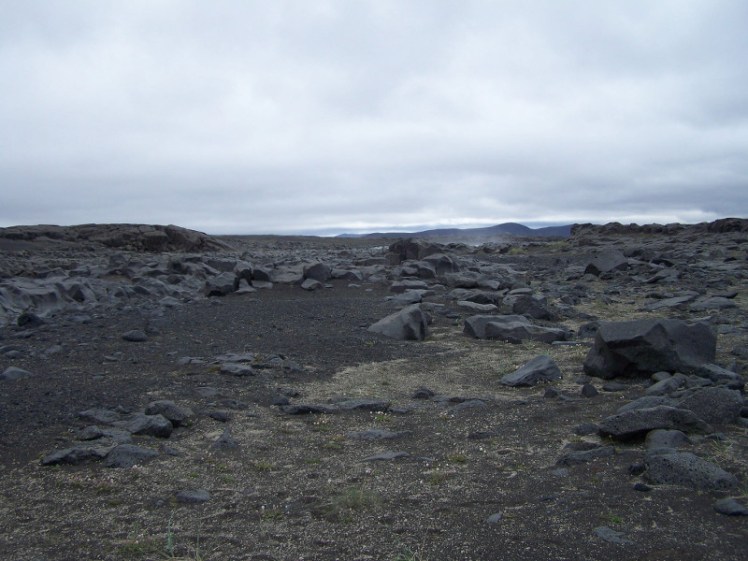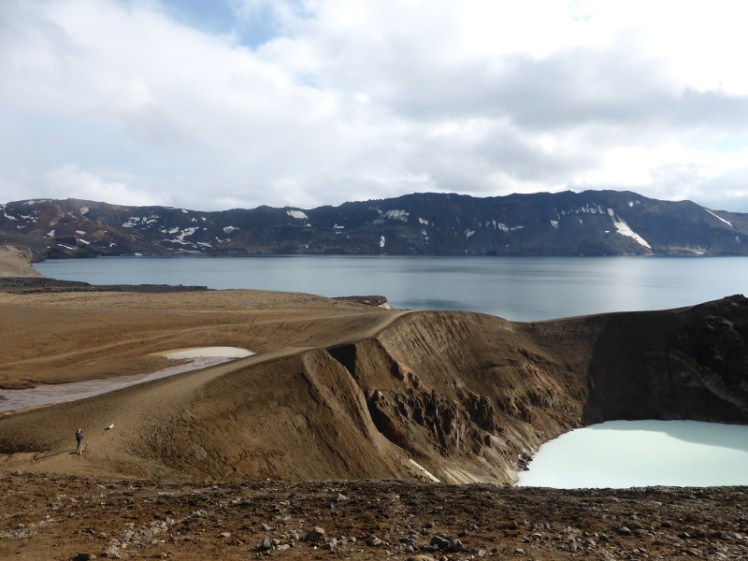It was the summer of 2013. I was in Iceland. I had a bus passport and a little yellow one-man tent and I was circling the Highlands, Iceland’s inhospitable Interior. I’d already lost a day by not reading the bus timetable correctly, although a day accidentally spent at Landmannalaugar is certainly not wasted. And so I arrived at my campsite on the shores of Lake Mývatn on the afternoon before my birthday.
I was picked up at the crack of dawn on my actual birthday. That’s one of my favourite overused phrases. Although Iceland doesn’t have true Midnight Sun, it doesn’t really get dark in the summer therefore no crack of dawn. Because I didn’t realise the tiny village had two campsites – or how big the village could feel when carrying my camping stuff – I had to walk down to Hlið to catch the truck. And what a truck! I don’t know what it was – definitely a Ford. A big 4×4? A small minibus? A former people-carrier? Anyway, it had been propped up on giant suspension and had 46 inch tyres. And guess which solo traveller gets to sit in the front seat?

We drove across the Ódáðahraun, a lava field whose name translates to “The Desert of Misdeeds”, which is the best name ever. It’s endless and grey and cold and wet and the road is a track across actual lava and black sand and later, a coating of golden-white pumice (I took a little piece home. It floats!). We made a couple of stops. We stopped at Herðubreiðarlindir, an oasis, campsite, toilet & home to an outlaw’s cave. We went down Dragon Canyon and we had lunch at the Dreki hut, which is just below Askja. And with that all done, it was off to the main event, the thing I’d looked forward to more than anything else in my entire life.

Askja is a volcano. More than that, she’s a caldera, pretty vast by my experience – by which I mean that Askja is my first caldera and it looks enormous. You park on the edge of it and then walk thirty-five minutes to the edge of the lake, which is where part of the caldera is flooded. In good weather, you can see a ring of mountains around the horizon, except that the horizon is actually the rim of the caldera you’re walking in. That’s how big it is. You cross patches of snow all year round on this walk. If it’s snow, that’s good. When we crossed, it was deep slush. Even the gravelly parts of the walk are snow deeper down. It’s just that it got coated in gravel and ash and pumice and filth the last time Askja exploded and that insulates the snow deep down.


But it wasn’t good weather that day. Despite being July, it was damp and cold and there was a big heavy cloud sitting right on top of Askja. If it lifted a little, you could just make out slopes to your left but that was it. I’d been looking forward to seeing the famous lake but it was invisible. You don’t go in the lake. It’s the sort of lake on which people mysteriously vanish and the bodies are never found. We went in the smaller lake.

Víti is a crater beside the lake, formed by an explosion in 1724. It’s flooded with milky-white water, just about the temperature of your average municipal swimming pool. It’s not warm but considering the temperature of the lake right beside it, it’s tropical.

We scrambled down the side, which is muddy and unstable and slippery, got changed on a patch of “beach” and went in. I’m so glad I didn’t know at the time that it’s 170m deep. I panic swimming in a pool 5m deep. But you can’t see the bottom. Nonetheless, I stayed where I could feel the bottom, although it feels very fragile. I couldn’t quite shake the feeling that if I kicked too hard, I could collapse the entire pool and plummet into the bowels of the Earth, along with a big swirling drain of warm water.

I think I’d acquired a drybag by then. I’d left most of my clothes in it and we changed on the little beach again, in the drizzle and the wind and the cold. It was a uniquely unpleasant experience. We climbed back out of the crater, trekked back to the truck and headed for home.

However! Give or take the weather, things had gone far too smoothly. We weren’t going straight back up the Ódáðahraun like we’d come down, we were going up a more or less parallel road to the east of it, stopping for “leader sheep soup” at a village called Möðrudalur, although we were instructed to not try the Icelandic tongue-twisting pronunciation and to just call it Mordor. And then the truck broke down.

As far as I can understand, it needs some special oil. We’re 70 miles from the nearest real settlement – the tiny village where I was camping – and 130 miles from the nearest big town. That’s not so much but bear in mind the terrain. It had taken at least three hours to get here. It’s another hour from Reykjahlið to Akureyri. We sat beside Iceland’s most ferocious river for a long time. I don’t even know how long. I sat and picked every speck of mud out of my poor camera. I felt hypothermia beginning to set in – we can’t sit and wait with the engine running, of course, and we were already cold and damp from the swim and the walk. We’ve already eaten whatever food we’ve brought.
We did offload two passengers onto a passing 4×4 but there wasn’t room for the rest of us. Some of us hadn’t grasped the scale or the terrors of the Ódáðahraun and were convinced we could walk to Mordor. Does it need to be said? Of course it does. I used every opportunity that came up to say it.
“One does not simply walk into Mordor.”
We were rescued by a young man with a pick-up truck who brought us some special oil. His name was Odin. Well, in the Icelandic spelling it’s Óðinn. We got the truck going well enough to travel maybe twenty minutes at a time before needing to stop. Óðinn shadowed us all the long long way to Mordor and we broke down, finally and unequivocally, within sight of the “Welcome to Mordor” sign. We could walk from here. We could see the place.
But no. One does not simply walk into Mordor. Óðinn produced a rope and towed us the couple of hundred yards into the village. We settled down in the inn – neither pub, restaurant nor café quite fit the place – and sat eating leader sheep soup until a people-carrier arrived to take us back to civilisation.
Actually, it wasn’t our first truck problem of the day. We’d stopped beside a small waterfall to admire it and someone had accidentally leaned on the little pop-up thing as they got out – and locked the truck with the engine running and the keys inside. We used the time to take selfies with the monster and eventually got back in with the aid of a broom strapped to the outside. But that little accident paled so far into significance that we all forgot it long before the end of the day.
I don’t know what time I was due home. I got home at 11.30pm. I admitted, finally, that it had been an interesting birthday and got Happy Birthday sung to me, in a car park, on the edge of a volcanic lake, in the shadow of an active volcano, by half a dozen people whose native language is not English.
And then I returned to my tent.
2 thoughts on “I swam in a volcano, got rescued by Odin and walked into Mordor”